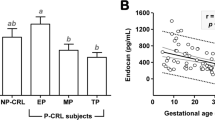Abstract
Objective
The emerging role of transforming growth factor β in hypertension, kidney disease, and trophoblast differentiation promoted our interest in evaluating the clinical value of assaying maternal serum TGF-β2 levels in pregnancies complicated by preeclampsia and eclampsia. We wished to determine these levels in relation to the severity of the disease, the degree of renal involvement, and fetal outcome.
Methods
A prospective study was carried out in 50 pregnant patients with preeclampsia (PE) and eclampsia and these women were compared to 20 pregnant normotensive controls. Preeclamptic patients were subdivided into 20 cases of mild PE, 20 cases of severe PE, and 10 cases of eclampsia. Maternal serum levels of TGF-β2 were determined in all cases by enzyme immunoassay. Maternal serum creatinine and uric acid were measured, together with an assessment of fetal well being, using the Biophysical Profile Score.
Results
Maternal serum TGF-β2 levels were significantly increased in cases of severe preeclampsia and eclampsia compared to controls. This increase was positively correlated with elevated levels of serum creatinine and uric acid, as well as poor biophysical profile scores (BPS), and low birth weight (LBW).
Conclusion
Measurement of maternal serum TGF-β2 levels in preeclampsia may be a useful biomarker for the assessment of the severity of disease and fetal outcome in PE.
Similar content being viewed by others
References
Hughes EC, ed. Obstetric gynecologic terminology. Philadelphia: Davis, 1972.
Greer IA, Lyall F, Perera T, Boswell F, Macara LM. Increased concentrations of cytokines IL-6 & IL-1 receptor antagonist in plasma of women with preeclampsia: A mechanism of endothelial dysfunction. Obstet Gynecol 1994;84:937–40.
Roberts JM, Taylor RM, Musci JT. Endothelial cell activation as pathogenic factor in preeclampsia. Semin Perinatol 1991 ;15:86–93.
Djurovic S, Schjetlein R, Wisloff F, Hangen G, Husby H, Berg K. Plasma concentrations of Lp(a) lipoprotein and TGFβ1 are altered in preeclampsia. Clin Genet 1997;52:371–6.
Sharma A, Ziyadeh FN. The emerging role of transforming growth factor-B in kidney disease. Physiology 1994;266:829–42.
Dungy LJ, Siddiqi TA, Khem S. Transforming growth factor β1 expression during placental development. Am J Obstet Gynecol 1991; 165:853–7.
Caniggia I, Mostachfi H, Winter J, et al. Hypoxia-induced factor-1 mediates the biological effects of oxygen on human trophoblast differentiation through TGFβ3. J Clin Invest 2000; 105:577–87.
Caniggia I, Grisaru-Gravnosky S, Kuliszewsky M, Post M, Lye SJ. Inhibition of TGFβ3 restores the invasive capability of extravillous trophoblasts in preeclamptic pregnancies. J Clin Invest 1999;103:1641–50.
Caniggia I, Winter J, Lye SJ, Post M. Oxygen and placental development during the first trimester: Implications for the pathophysiology of preeclampsia. Placenta 2000;21:25–30.
Cunningham FG, MacDonald PC, Gant NF, Levens KS, Gilstrop J, eds. William’s obstetrics. Norwalk, Connecticut: Appleton and Lang, 1993:763–818.
Manning FA. Dynamic ultrasound based fetal assessment: The fetal biophysical profile score. Clin Obstet Gynecol 1995;38:26–34.
Van Snik J. IL-6 an overview. Annu Rev Immunol 1990;8:253–78.
Vince GS, Starkey PM, Ausgulen R, Kwiatkowski D, Redman CWG. IL-6 and the soluble receptors in women with preeclampsia. Br J Obstet Gynaecol 1995;192:205–10.
Gibbons GH, Pratt RE, Dzau VJ. Vascular smooth muscle cell hypertrophy vs hyperplasia: Autocrine transforming growth factor-β expression determines growth response to angiotensin II. J Clin Invest 1992;90:456–61.
Wolf G, Muller E, Stahl RAK, Ziyadeh FN. Angiogenin II-induced hypertrophy of cultured murine proximal tubular cells is mediated by TGFβ. J Clin Invest 1993;92:1366–72.
Border WA, Rouslahti E. Transforming growth factor-P in disease, the dark side of tissue repair. J Clin Invest 1992;90:1–7.
Stallmach T, Hebisch G, Toller H, et al. Expression pattern of cytokines in the different compartments of the feto-maternal unit under various conditions. Reprod Fertil Devel 1995;7: 1573–80.
Author information
Authors and Affiliations
Rights and permissions
About this article
Cite this article
Shaarawy, M., El Meleigy, M. & Rasheed, K. Maternal Serum Transforming Growth Factor Beta-2 in Preeclampsia and Eclampsia, a Potential Biomarker for the Assessment of Disease Severity and Fetal Outcome. Reprod. Sci. 8, 27–31 (2001). https://doi.org/10.1177/107155760100800105
Published:
Issue Date:
DOI: https://doi.org/10.1177/107155760100800105




